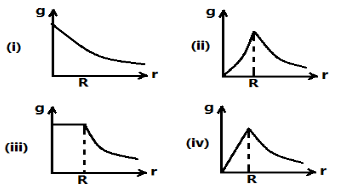
The dependence of acceleration due to gravity g on the distance r from the centre of the earth assumed to be a sphere of radius R of uniform density is as shown figure below.
The correct figure is

A. (i)
B. (ii)
C. (iii)
D. (iv)

Answer
577.2k+ views
Hint: Acceleration due to gravity is a constant numerical value but it is almost constant only outside surface of the earth, if we consider the acceleration due to gravity inside the earth and consider the centre of the earth as origin then the value of the acceleration due to gravity changes according to the distance of the consideration point from the centre of the earth.
Complete answer:
As we know that the acceleration due to gravity at some depth d below the surface of earth will have some other value than the standard value of the acceleration due to gravity that is 9.8m/s2.
So, we have one formula for the above,
Let the acceleration due to gravity at some depth $d$ below the earth surface is $g'$.
So, we have a formula as follows,
$g' = g\left( {1 - \dfrac{d}{R}} \right)$
On simplifying this formula, we get
$g' = g\left( {\dfrac{{R - d}}{R}} \right)$
As we have assumed that the depth of the point at which we are concentrating for the value of the acceleration due to gravity is $d$, and if we subtract this value from the radius of the earth then we will find the position of the distance r from the centres of the earth that is mentioned in the question as $r$.
So mathematically we can write like,
$R - d = r$
So now the formula will change like,
$g' = \dfrac{{rg}}{R}$------equation (1)
Fromm the above equation we have got,
If $r = 0$then $g' = 0$
So $g'$ is directly proportional to the value of $r$ until $r = R$.
Because, When $r = R$ then $g' = g$
Now if $r > R$ then there is some other formula for the acceleration due to gravity, that is $g' = \dfrac{{g{R^2}}}{{{{(R + h)}^2}}} = \dfrac{{g{R^2}}}{{{r^2}}}$ (since $(R + h) = r$)
From this we can get the following relation,
$g' \propto \dfrac{1}{{{r^2}}}$
Hence the variation of the acceleration due to gravity will be a straight line passing through the origin and after $r > R$ it will be parabolic.
So, the graph shown in the diagram (iv) is depicting the correct scenario.
So, the correct answer is “Option D”.
Note:
We have seen that the value of the acceleration due to gravity varies with respect to the distance from the centre of the earth. This is because the earth is not a pure sphere, its shape is slightly different from the sphere. It is an oblate spheroid. Its radius near the equator is more than the radius near the poles.
Complete answer:
As we know that the acceleration due to gravity at some depth d below the surface of earth will have some other value than the standard value of the acceleration due to gravity that is 9.8m/s2.
So, we have one formula for the above,
Let the acceleration due to gravity at some depth $d$ below the earth surface is $g'$.
So, we have a formula as follows,
$g' = g\left( {1 - \dfrac{d}{R}} \right)$
On simplifying this formula, we get
$g' = g\left( {\dfrac{{R - d}}{R}} \right)$
As we have assumed that the depth of the point at which we are concentrating for the value of the acceleration due to gravity is $d$, and if we subtract this value from the radius of the earth then we will find the position of the distance r from the centres of the earth that is mentioned in the question as $r$.
So mathematically we can write like,
$R - d = r$
So now the formula will change like,
$g' = \dfrac{{rg}}{R}$------equation (1)
Fromm the above equation we have got,
If $r = 0$then $g' = 0$
So $g'$ is directly proportional to the value of $r$ until $r = R$.
Because, When $r = R$ then $g' = g$
Now if $r > R$ then there is some other formula for the acceleration due to gravity, that is $g' = \dfrac{{g{R^2}}}{{{{(R + h)}^2}}} = \dfrac{{g{R^2}}}{{{r^2}}}$ (since $(R + h) = r$)
From this we can get the following relation,
$g' \propto \dfrac{1}{{{r^2}}}$
Hence the variation of the acceleration due to gravity will be a straight line passing through the origin and after $r > R$ it will be parabolic.
So, the graph shown in the diagram (iv) is depicting the correct scenario.
So, the correct answer is “Option D”.
Note:
We have seen that the value of the acceleration due to gravity varies with respect to the distance from the centre of the earth. This is because the earth is not a pure sphere, its shape is slightly different from the sphere. It is an oblate spheroid. Its radius near the equator is more than the radius near the poles.
Recently Updated Pages
Master Class 11 Economics: Engaging Questions & Answers for Success

Master Class 11 English: Engaging Questions & Answers for Success

Master Class 11 Social Science: Engaging Questions & Answers for Success

Master Class 11 Biology: Engaging Questions & Answers for Success

Class 11 Question and Answer - Your Ultimate Solutions Guide

Master Class 11 Business Studies: Engaging Questions & Answers for Success

Trending doubts
What is meant by exothermic and endothermic reactions class 11 chemistry CBSE

What are Quantum numbers Explain the quantum number class 11 chemistry CBSE

What is periodicity class 11 chemistry CBSE

Explain zero factorial class 11 maths CBSE

What is a periderm How does periderm formation take class 11 biology CBSE

Mention the basic forces in nature class 11 physics CBSE




